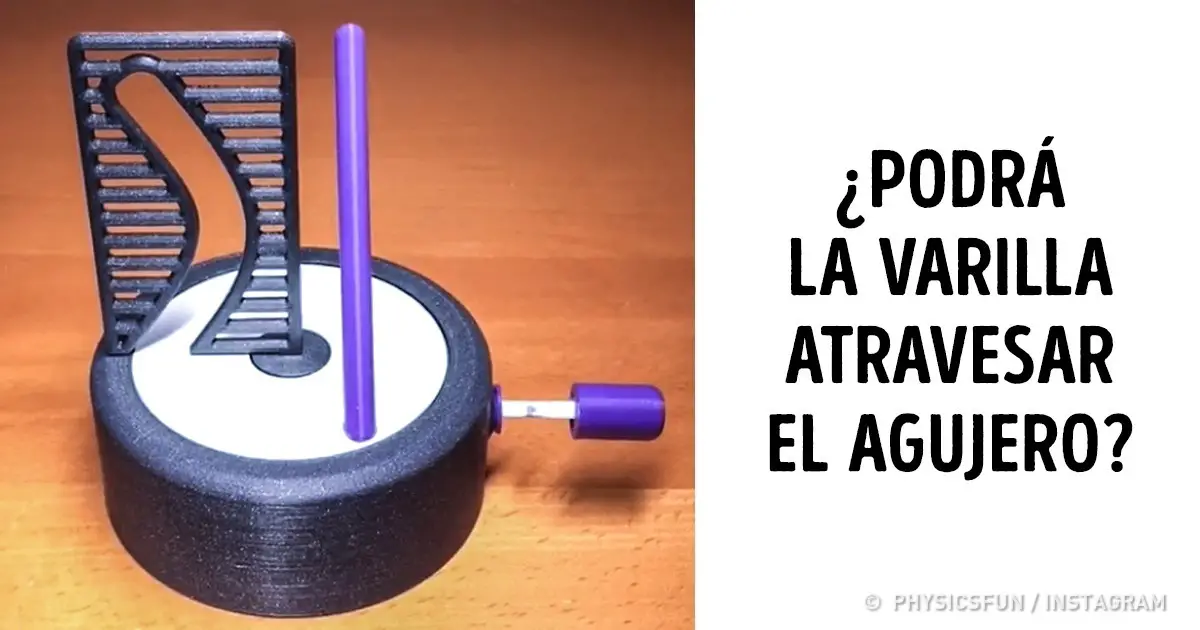El científico Ray Hall hace y filma nuevos experimentos todos los días. Gracias a su inventario especial, a veces los fenómenos físicos comunes parecen magia en los videos de Ray. El científico muestra objetos que cambian de forma dependiendo del ángulo en que lo veas, líquidos en movimiento y trucos con cadenas auto-retorcibles o vino que desaparece.
Decidimos recolectar los experimentos más interesantes de Ray Hall y mostrártelos para que puedas apreciar qué tan bella e interesante puede ser la ciencia.
15.
El modelo diseñado en la Universidad Meiji de Japón fue creado para poder “cambiar” la forma dependiendo del ángulo de visión. Las líneas encorvadas crean una ilusión óptica por la cual el mismo objeto y su reflejo se ven completamente diferentes para la persona.
14.
Debido al sonido que produce el bote en movimiento, uno podría pensar que es un típico juguete infantil con motor. En realidad, tenemos una máquina de vapor simplificada, patentada en 1915. En este caso, para que el bote pueda avanzar, el científico le prende fuego a una vela convencional y la pone dentro de la cabina metálica de la que salen 2 tubos.
13.
El movimiento caótico de luz LED se proporciona por medio de dos péndulos, uno de los cuales está sujetado al extremo del otro. Los patrones que produce la lucecita se ven muy lindos.
12.
Un modelo que demuestra cómo se ve un campo magnético. Diminutas partículas de hierro que flotan en aceite viscoso circulan atraídas por el imán.
11.
Esta copa representa una variación de la tan popular la copa de Pitágoras en la Antigua Grecia. Puede ser utilizada para tomar vino siempre y cuando no la llenes demasiado.
En el medio de la copa está un espacio con una barra doblada en dos. Además, un extremo de la barra queda dentro de la copa y el otro extremo sale. Y hay una ligera diferencia en altura entre ellos.
Cuando viertes vino en la copa, comienza a regir la ley de vasos comunicantes y el líquido sube por la barra. Sin embargo, permanece dentro de la copa hasta que suba más arriba de la curva de la barra. Entonces, dentro de la varilla, el líquido se desborda y sale por el orificio externo.
10.
Este modelo que utiliza una cuerda enrollada en una varilla con un peso muestra cómo la energía potencial se transforma en energía cinética, haciendo que la viga de madera oscile y gire.
9.
Otra ilusión óptica. Como en el caso anterior, nuestro ojo percibe el sujeto dependiendo del ángulo de visión. Esto no solo hace que la flecha siempre apunte al mismo lado, sino que también la hace lucir diferente de su propio reflejo.
8.
Al inicio, parece que una varilla recta no podría atravesar el orificio encorvado, pero, moviéndose en círculo, pasa a través del arco gradualmente de arriba hacia abajo. Esto lo garantiza el hecho de que la varilla está inclinada en un ángulo.
7.
Miren el lindo movimiento de la pintura metálica en una mezcla de agua y alcohol. Así es como interactúa la fuerza magnética con la tensión de la superficie.
6.
Podríamos pensar que este truco es el resultado de video montaje, pero su esencia real se revela solo si lo ves en modalidad de cámara lenta. De acuerdo a la tercera ley de Newton, el anillo, cayendo y girando transmite el impulso al extremo final de la cadena, forzándola a subir y deslizarse adentro del nudo.
5.
Otra ilusión que se hizo posible gracias al nivel correcto de visión y una forma del objeto bien pensada que parece ser redondo y angular al mismo tiempo.
4.
Un mini tren que se mueve a lo largo de la bobina de alambre de cobre. Se crea un campo magnético alrededor de la batería lo que hace que se mueva a lo largo de la bobina hacia adelante.
3.
Esta imagen fue creada por el artista húngaro Istvan Oros. Al inicio, podemos ver las ilustraciones del libro de Julio Verne La isla misteriosa. Pero, si ponemos una bombilla de espejo que permite “unir” el reflejo, podemos ver el retrato del escritor.
2.
Algunos escarabajos que tienen brillo metálico solo pueden reflejar la luz polarizada. Este escarabajo delante de nosotros refleja la luz de ambas polarizaciones. Por esto, si lo vemos a simple vista, el color del insecto en su reflejo del espejo no cambia.
Pero si usamos filtros especiales que permiten ver solo luz polarizada hacia la izquierda o derecha, el color del escarabajo y de su reflejo cambia (debido a que, en el reflejo, la dirección de la polarización se cambia a la opuesta).
1.
El movimiento de estas bolas metálicas no demuestra otra ley física, sino la ley de rendimientos del mercado de valores. La gráfica roja muestra la distribución de ingresos mensuales, según los datos recopilados en los últimos 50 años.
Si lo vemos con cámara lenta, quedará claro que el camino de cada una de las 3000 bolas hechas a través de los 12 “cruces” es inestable y caótico, por esta razón, la distribución de las bolas siempre resulta diferente, pero conduce a un resultado parecido al declarado.

